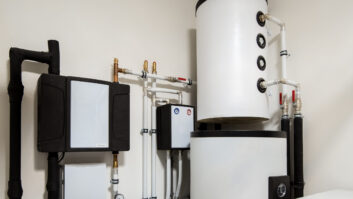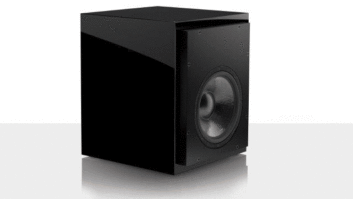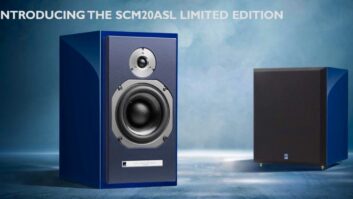NEW YORK —
As the first of the 2011 3DTVs start to
arrive in retail stores, the consumer electronics industry
finds itself in the throes of a new consumer format conundrum
— passive or active-shutter 3D glasses?
TVs compatible with the 3D Blu-ray Disc standard
first appeared last year, all using so-called active-shutter
glasses. These glasses are battery powered and actively
switch on and off the left- and right-eye views in alternating
sequence to produce 3D images, in some cases in
Full 1080p HD resolution. All were launched with great
fanfare and promotion, but saw lukewarm (1.3 million units
overall) sell-through numbers at the end of the year.
Some consumer studies traced this to, in part, a general
rejection to the notion of wearing expensive special
glasses to get the 3D effect.
One year later, a new crop of 3DTVs based on passiveglasses
3D technology (also known as Film Patterned Retarder,
FPR technology) are being positioned by a handful of
manufacturers as the savior of the stereoscopic revolution.
The technology is said to address most of the concerns
consumers have expressed about active-shutter 3D
glasses: cost, discomfort, cross-talk artifacts and style
challenges.
But experts have said active shutter has the edge in
brightness and delivering higher-resolution images, while
LG’s FPR tech is cheaper, lighter and more comfortable
to wear.
The first hints of what may follow came last December,
after Vizio first introduced a 65-inch LCD flat-panel display
based on passive-glasses 3D technology. The company
reported unexpectedly heavy demand. Supplies
quickly sold out, leaving the company to gear up more
volume while expanding the line to a wider assortment
of screen sizes.
Although its passive-glasses 3D LCD TVs don’t require
expensive battery-powered active-shutter glasses, Vizio
has positioned the technology as its premium 3DTV offering,
listing the 65-inch set at a $3,500 suggested retail.
This takes into account the added bill of materials required
to build the technology into the set.
In contrast, LG Electronics, which is shipping the first
of its passive 3D TVs (called Cinema 3D) sets to market
now, has positioned passive 3D LCD TVs as its entry into
the 3D mix, offering active-shutter glasses technology in
step-up LCD TV and plasma TV lines.
Passive 3D LCD “is a better experience overall, more
like you get in the cinema,” said James Fishler, LG go-tomarket
operations senior VP, adding: “We’ll keep activeshutter
3D in our lineup, though. At the high end, with all
the other bells and whistles, it’s a different experience.”
Toshiba, which will ship its first passive sets soon, is
also positioning the technology at the entry end of its
stereoscopic 3D assortment. The company will keep active-
shutter models as its higher performers. In Japan the
company is also selling large-screen auto-stereoscopic
(glasses-free) 3D LCD TVs, but has no plans for that in
the U.S. at this time.
Meanwhile, Samsung threw a wild card into the game at
International CES when it announced a hybrid technology
that places active-shutter switching in the panel, enabling
viewers to wear passive polarized glasses like those used
in FPR sets.
DisplaySearch’s Paul Gagnon, North American TV
research director, called Samsung’s approach “active retarder”
technology because it uses a second LCD panel
to actively switch polarization.
“It’s kind of a best-of-both-worlds approach using lowcost
glasses, but without a resolution hit,” Gagnon said,
pointing out that one of the big drawbacks of LG’s FPR
passive 3D approach is that it cuts resolution in half.
“These will probably debut as the highest performance
3DTVs, giving the industry a good-better-best strategy, although
there will be fierce debate this year as to whether
passive- or active-shutter glass 3D is the good or better
candidate, depending on brand viewpoint. We probably
won’t see active-retarder-type 3D sets until next year, and
they will be expensive.”
Meanwhile, Sony and Samsung continue to stick to
active-shutter LCD 3D displays, although LG executives
in Korea recently mentioned that they have engaged additional
manufacturers including Sony in discussions about
adopting FPR 3D LCD panels.
In its quest to reign supreme atop the 3D TV market, LG
is offering passive 3D sets at low adoption prices despite
a potentially higher manufacturing cost.
“Cost is definitely an issue here, and while passive sets
will have a lower total cost than active when accounting
for four pairs of glasses being included, some 120Hz active
3D LCD TV sets will be available that could have the
lowest absolute cost of the set since no glasses are included,”
Gagnon told TWICE. “This would be an option
for consumers just looking to future-proof their set, without
jumping fully into 3D from the start.”
Guido Voltolina, COO of 3D glasses manufacturer
Xpand, which makes active-shutter 3D glasses solutions,
said he found it somewhat ironic that LG Electronics, which
has a large plasma TV production interest, would lead the
charge for passive 3D technology. Currently, the passive
3D system does not work economically with plasma technology,
and plasma sets are top active-shutter 3D performers,
due to their faster switching speeds.
“Plasma is already active compatible without any additional
cost,” Voltolina observed. “It is always important to
see the impact on 2D viewing performance, when adding
any 3D technology. Taking away performance in 2D is less
likely to have wide acceptance as the majority of the content
will be viewed that way.”
So where does this leave plasma? At least for now, FPR
technology has not been applied to plasma displays, but
Samsung and LG are applying active-shutter 3D technology
to 720p resolution plasma models to lower the cost
and push adoption.
“3D was important for plasma, but not the driver of the
strong growth in 2010,” Gagnon observed. “The 2010
plasma growth rebound was attributable to low-cost 720p models, not high-end 3D 1080p models.
We are expecting the plasma market to start
slowly contracting in 2011, but the 3D share
will grow.”
While 720p 3D plasma should be popular
in 2011, “most models of 3D plasma will be
1080p,” Gagnon said.
To date, virtually all of the 3DTV activity has
been applied to screen sizes measuring 42
inches and larger. Gagnon believes that will
continue to be the case for the most part for the
next few years.












